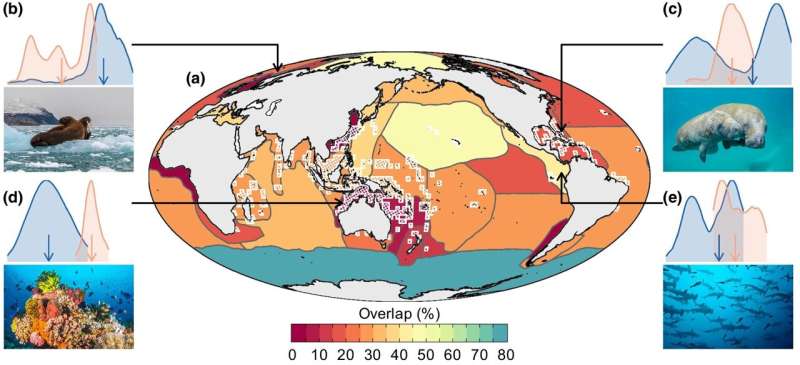Exposure to future changes in rates of oceanic warming. Map (a) showing overlap (%) in rates of ocean warming in 30 marine biogeographic realms pre- and post-industrialisation (under a future RCP 4.5 scenario). Density plots of rates of rapid warming in four marine biogeographic realms pre- and post-industrialisation: North Atlantic boreal & sub-Arctic (b), Caribbean and Mexican gulf (c), tropical Australia and Coral Sea (d), and gulf of California (e). Blue indicates pre-industrialisation, orange indicates post-industrialisation under RCP 4.5. Colored arrows in plots (b–d) show median values. Hatched areas in (a) (outlined in white) show hotspots of MSR. Overlap for RCP 8.5 can be found in Figure S2. Credit: Global Change Biology (2022). DOI: 10.1111/gcb.16328
An international team of scientists led by researchers from the University of Adelaide has revealed that rates of future warming threaten marine life in more than 70% of the most biodiverse-rich areas of Earth's oceans.
"Our research shows that locations with exceptionally high marine biodiversity are the most exposed to future oceanic warming, making them particularly vulnerable to 21st century climatic change," said lead author Dr. Stuart Brown from the University of Adelaide's Environment Institute
"This is because species living in these biodiverse regions are generally ill-equipped to respond to large changes in temperature."
Using a new technique for comparing past and future extreme rates of oceanic warming, the researchers were able to map global exposure to future climate change and establish distances that plants and animals in vulnerable areas need to move to track suitable climatic conditions.
"In many cases this will require moving distances beyond the oceanic regions that these species evolved in and are adapted to, at rates of movement rarely seen for marine life," said Dr. Brown.
"By showing that areas of high marine biodiversity are disproportionately exposed to future warming, our results provide important new information for deriving and strengthening conservation actions to safeguard marine biodiversity under climate change," stated University of Adelaide's Associate Professor Damien Fordham, also from the Environment Institute.
The most vulnerable marine communities contain most of the world's reef-building coral species, which provide ecosystem services that support the livelihoods of millions of people. Other vulnerable regions are home to iconic marine megafauna including manatees.
"While we have known for some years that recent human-induced climate change is affecting marine life through shifts in species distributions and abundances, the spatial pattern of exposure to past and future fast rates of ocean warming has been unclear," said Fordham.
"By showing that areas of high marine biodiversity are disproportionately exposed to future warming, our results provide important new information for deriving and strengthening conservation actions to safeguard marine biodiversity under climate change.
"Actions that strengthen ecological and evolutionary resilience to climate change should be a priority. These could include improving fisheries management, assisting the movement of species, and the expansion of well-managed, climate-smart marine protected areas."
The research published in Global Change Biology shows that even under a relatively conservative scenario of future climate change, hotspots of marine biodiversity are highly vulnerable to accelerated ocean warming.
More information: Stuart C. Brown et al, Faster ocean warming threatens richest areas of marine biodiversity, Global Change Biology (2022). DOI: 10.1111/gcb.16328
Journal information: Global Change Biology
Provided by University of Adelaide
























